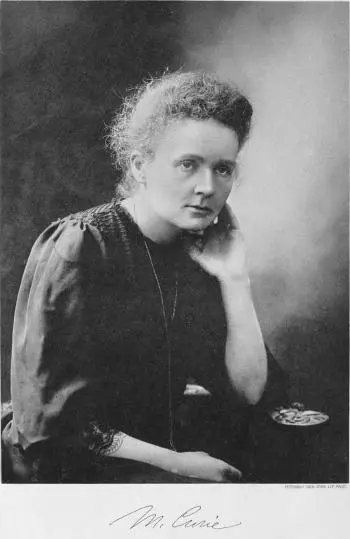
Marie Curie, whose birth name was Maria Skłodowska, was born on November 7, 1867 in Warsaw, Poland, under Russian rule.
Despite facing obstacles due to her gender and ethnicity, Marie showed a keen interest in science from an early age. After obtaining her education in Poland, she moved to Paris in 1891 to continue her studies at the University of Paris (Sorbonne).
In 1895, she met Pierre Curie, a French physicist, whom she married in 1895. Together, they undertook pioneering research on radioactivity, a term Marie herself coined. Her work focused on the phenomena of radiation emitted by radioactive elements, such as uranium and thorium.
Marie Curie was not only an exceptional scientist, but also a pioneering woman in a field dominated by men in her time. Her work and dedication to science paved the way for future generations of scientists and contributed significantly to the development of nuclear power and the understanding of modern physics and chemistry.
For her outstanding contributions, Marie Curie is remembered as one of the most influential scientists in history and continues to be a source of inspiration to many around the world.
Marei Curie's contributions to nuclear power
Marie Curie's main contributions to nuclear energy are as follows:
Discovery of radioactive elements
In 1898, Marie Curie and Pierre Curie isolated two new, highly radioactive elements, which they named polonium and radium, after Poland and Marie's work. These discoveries radically changed the understanding of the nature of matter and established the foundations of radioactivity.
Discovery of radioactivity
Marie Curie played a key role in the discovery of radioactivity.
In 1896, Marie Curie, together with her husband Pierre Curie, began to investigate the mysterious phenomena of uranium radiation, discovered by the physicist Henri Becquerel. Through her hard work and dedication, Marie and Pierre Curie were able to isolate and study highly radioactive new elements, polonium and radium, which turned out to be much more radioactive than uranium.
Marie Curie's pioneering work led her to coin the term "radioactivity" to describe the ability of certain elements to emit radiation without the need for an external source.
His research laid the foundation for the development of nuclear physics and the understanding of atomic structure. In 1903, her outstanding work was recognized with the Nobel Prize in Physics, which she shared with her husband Pierre Curie and Henri Becquerel.
Contributions to atomic theory
Marie Curie's discoveries helped develop atomic theory and led scientists to understand that atoms were not indivisible, but rather contained subatomic particles. This was a crucial step in the evolution of atomic theory.
By studying radioactive emissions, they realized that certain atoms were unstable and decayed into subatomic particles. These observations laid the foundation for the later development of the model of the atom and the understanding of its internal structure.
His investigations paved the way for future scientists, such as Ernest Rutherford and Niels Bohr, who developed the model of the atom based on the atomic nucleus, electrons, and electronic orbits.
Contribution to medicine
Marie Curie's contribution to medicine was significant and revolutionary, especially in the field of medical diagnosis and treatment through the use of radiation.
Some of his most outstanding contributions to nuclear medicine are the following:
-
Radiography: During World War I, Marie Curie worked to develop mobile X-ray units, known as "petites Curies," to diagnose and treat wounded soldiers on the front lines.
-
Radiation therapy: Along with her daughter Irène Joliot-Curie, Marie Curie also investigated the use of radiation to treat cancerous tumors. Her work laid the foundation for modern radiation therapy, a common form of treatment for certain types of cancer that uses ionizing radiation to damage and destroy cancer cells.
-
Founding of the Curie Institute: Marie Curie founded the Radium Institute, which later became the Curie Institute, a medical and scientific research center dedicated to radiotherapy and radiobiology. The institute continues to be a major center for cancer research and treatment in France.
Death
Marie Curie died on July 4, 1934 at the age of 66. Her death was due to complications from prolonged exposure to radiation throughout her scientific career.
During their research on radioactivity, Marie and her husband Pierre Curie were exposed to high levels of radiation without being aware of the dangers involved at the time.
Over the years, Marie Curie worked with highly radioactive materials, such as polonium and radium, without proper shielding. This resulted in significant exposure to ionizing radiation, which subsequently caused serious health problems.